West African Lion
- February 8, 2024
- 0 comment
The West African Lion, also known as the Senegal Lion or the Mali Lion, is a captivating and iconic species native to the vast landscapes of West Africa. Renowned for its majestic presence and awe-inspiring roar, this magnificent feline holds a special place in both the ecosystem and the hearts of people across the region. With its golden coat and striking black mane, the West African Lion stands as a symbol of strength, resilience, and natural beauty.

As apex predators, these lions play a crucial role in maintaining the balance of their ecosystems by regulating prey populations and shaping habitat dynamics. However, despite their cultural significance and ecological importance, West African Lions face numerous threats, including habitat loss, human-wildlife conflict, and poaching. Efforts to conserve these majestic creatures and their habitats are essential to ensure their survival for future generations to admire and cherish.
| Specification | Description |
|---|---|
| Scientific Name | Panthera leo leo |
| Common Names | West African Lion, Senegal Lion, Mali Lion |
| Habitat | Savannas, grasslands, woodlands in West Africa |
| Geographic Range | Senegal, Mali, Niger, Nigeria, and other West African countries |
| Size | Males: Up to 250 kilograms; Females: Smaller |
| Mane Characteristics | Black, varying in size and color intensity |
| Diet | Primarily large ungulates such as antelopes, zebras, wildebeests |
| Behavior | Cooperative hunting, social prides, communication through vocalizations and body language |
| Conservation Status | Vulnerable due to habitat loss, human-wildlife conflict, and poaching |
| Threats | Habitat loss, human-wildlife conflict, poaching |
| Conservation Efforts | Protected areas, community-based initiatives, anti-poaching measures |
| Population Estimate | Approximately 400 individuals (subject to change) |
| Cultural Significance | Symbol of strength, courage, and leadership in local folklore and traditions |

The West African Lion (Panthera leo leo), also known as the Senegal Lion or the Mali Lion, is a majestic feline species native to the region of West Africa. These magnificent creatures play a vital role in the ecosystem, contributing to the balance of nature through their presence.
Habitat and Distribution
The West African Lion inhabits a variety of habitats across the region, including savannas, grasslands, and woodlands. These diverse ecosystems provide the lions with ample cover for hunting and shelter, as well as access to their preferred prey species. They are found primarily in countries such as Senegal, Mali, Niger, Nigeria, and other West African nations. Their distribution within these countries can vary based on factors such as prey availability, habitat suitability, and human activities. While historically widespread, the range of the West African Lion has become increasingly fragmented due to habitat loss and human encroachment. Conservation efforts aim to protect remaining lion populations and their habitats to ensure their long-term survival in the wild.

Physical Characteristics
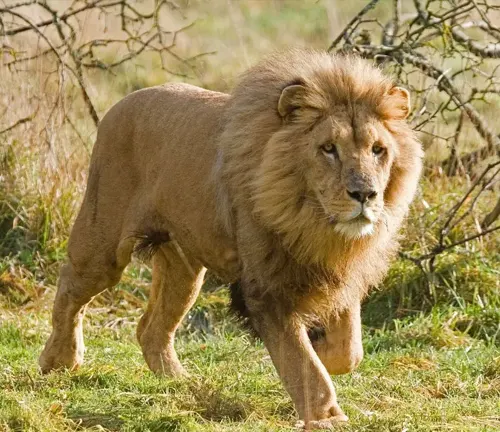
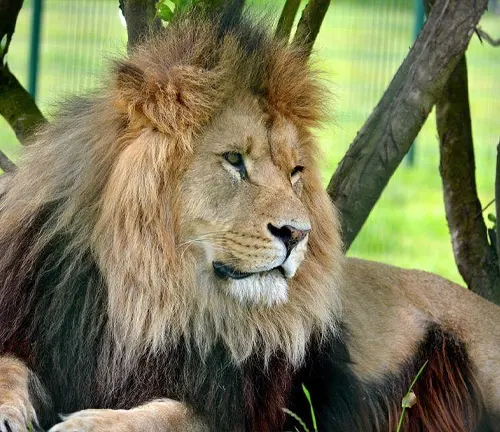

The West African Lion is characterized by its impressive physical features, which set it apart as one of the most formidable predators on the African continent. These majestic creatures typically exhibit a golden-yellow coat, although coloration can vary slightly among individuals and populations. One of the most striking features of the West African Lion is its mane, which adorns the neck and shoulders of males. The mane ranges in color from dark brown to black and varies in size and thickness depending on factors such as age and genetics. Male lions, known as “males,” can weigh up to 250 kilograms, while females, or “lionesses,” are generally smaller and lighter. Their powerful build and muscular physique contribute to their prowess as apex predators, allowing them to hunt and defend their territories with remarkable efficiency. Additionally, West African Lions possess sharp claws and powerful jaws, which they use to capture and subdue prey. Overall, the physical characteristics of the West African Lion reflect its status as a symbol of strength, resilience, and natural beauty in the African savannas.
Behavior and Social Structure
The behavior and social structure of the West African Lion are fascinating aspects of its biology, reflecting its adaptation to life in the savannas and grasslands of West Africa. These lions are highly social animals, forming complex social groups known as prides. A pride typically consists of related females, their offspring, and one or more resident males. The females are the primary hunters of the pride, working together to coordinate and execute successful hunts. Meanwhile, the males play a crucial role in defending the pride’s territory from intruders, which may include rival males or other threats.


Communication within the pride is vital for maintaining cohesion and coordination during hunting and territorial defense. West African Lions use a variety of vocalizations, including roars, growls, and grunts, to convey messages to one another. They also engage in scent marking, using urine and gland secretions to delineate territory boundaries and communicate reproductive status.
West African Lions may also form coalitions of males, typically brothers or unrelated individuals, which cooperate in defending territories and mating with females. These coalitions provide mutual support and increase the likelihood of successful reproduction for all members involved.
Diet and Feeding Habits
The diet and feeding habits of the West African Lion are essential aspects of its ecological role as a top predator in the region’s ecosystems. These majestic carnivores primarily prey on a variety of large ungulates, including antelopes, zebras, wildebeests, and occasionally buffalo and giraffes. Their choice of prey depends on factors such as availability, seasonality, and the size of the lion pride.
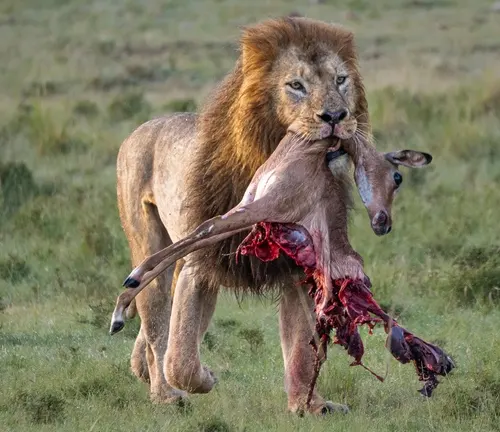

West African Lions are skilled hunters, employing a combination of stealth, teamwork, and ambush tactics to capture their prey. Females, with their smaller size and agility, often take the lead in hunting, using coordinated strategies to approach and bring down large herbivores. Once the prey is secured, the entire pride shares in the feast, with dominant individuals feeding first while subordinate members wait their turn.
In addition to hunting, West African Lions are opportunistic feeders, scavenging on carrion and leftovers from other predators whenever the opportunity arises. This behavior allows them to supplement their diet during times of scarcity or when hunting efforts are unsuccessful.
Feeding patterns among West African Lions can vary depending on factors such as prey availability, competition from other predators, and environmental conditions. During periods of plenty, lions may gorge themselves on large kills, consuming vast quantities of meat in a single feeding session. In contrast, during lean times, they may go days without a substantial meal, relying on their fat reserves to sustain them until the next successful hunt.
Conservation Status
Despite their cultural significance and ecological importance, West African Lions face numerous threats to their survival. Habitat loss, human-wildlife conflict, and poaching pose significant challenges to their conservation. Various organizations and governments are implementing conservation strategies to protect these iconic creatures and their habitats.
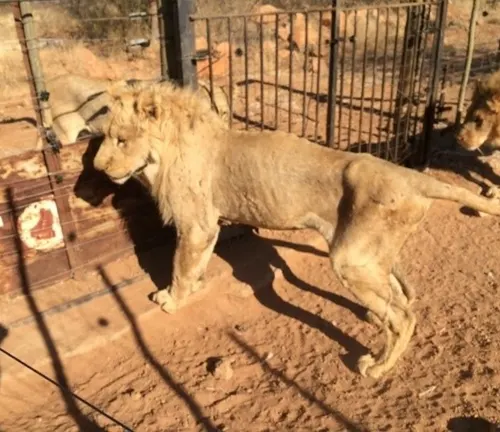
The conservation status of the West African Lion is a matter of concern, as the species faces various threats to its survival across its range. The International Union for Conservation of Nature (IUCN) lists the West African Lion as “Vulnerable,” indicating that its population is declining and it is at risk of extinction if conservation measures are not implemented effectively.
Habitat loss and fragmentation pose significant challenges to West African Lion populations. Human activities such as agriculture, urbanization, and infrastructure development encroach upon lion habitats, reducing available space and resources for these apex predators. As their habitats shrink, lions are forced into closer proximity to human settlements, increasing the likelihood of conflict between lions and local communities.
Human-wildlife conflict is another major threat facing West African Lions. Retaliatory killings and conflicts over livestock depredation occur when lions prey on domesticated animals, leading to negative perceptions of lions among communities and further exacerbating tensions between humans and wildlife.


Poaching and illegal trade also contribute to the decline of West African Lion populations. Lions are targeted for their body parts, which are used in traditional medicine and cultural practices. Additionally, trophy hunting and the illegal trade in lion bones further threaten the survival of these majestic predators.
Role in Tourism
The presence of lions in West African countries contributes to wildlife-based tourism, generating revenue and employment opportunities for local communities. Safari tours and wildlife viewing experiences offer visitors a chance to observe these magnificent creatures in their natural habitat, fostering appreciation for biodiversity conservation.

Different Species
There is only one species of lion, scientifically known as Panthera leo. However, within the population of lions found in West Africa, there may be regional variations or subspecies.
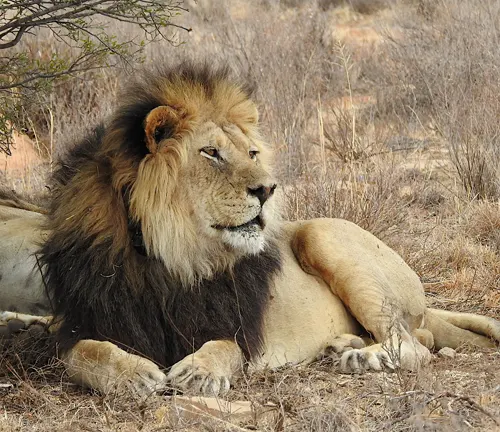
Frequently Asked Question (FAQs)
- What is the population size of West African Lions?
The population size of West African Lions is estimated to be around 400 individuals, although accurate counts are challenging due to their elusive nature and vast habitats. - How do West African Lions differ from other lion subspecies?
West African Lions are genetically distinct from other subspecies, with adaptations to their specific environment and prey preferences. They often exhibit smaller body sizes and darker mane colors compared to their counterparts in other regions. - What are the main threats facing West African Lions?
The main threats facing West African Lions include habitat loss, human-wildlife conflict, and poaching. These factors contribute to population declines and fragmentation of lion habitats across the region. - Are there any success stories in West African Lion conservation?
While challenges persist, there have been notable successes in West African Lion conservation, including the establishment of protected areas, community-based initiatives, and anti-poaching measures that have helped stabilize some populations. - How can individuals contribute to West African Lion conservation efforts?
Individuals can contribute to West African Lion conservation efforts by supporting conservation organizations, raising awareness about lion conservation issues, practicing responsible tourism, and supporting sustainable livelihoods for local communities living near lion habitats. - What is the role of West African Lions in their ecosystems?
West African Lions play a crucial role as apex predators in their ecosystems, helping to regulate prey populations and maintain the balance of the food chain. Their presence influences the behavior of prey species and shapes the structure of ecosystems. - How do West African Lions communicate within their prides?
West African Lions communicate within their prides through vocalizations, such as roars, growls, and grunts, as well as scent marking and body language. These forms of communication help coordinate activities such as hunting, territory defense, and social bonding. - Are West African Lions nocturnal or diurnal hunters?
West African Lions are primarily nocturnal hunters, although they may also hunt during the early morning or late afternoon hours. Their nocturnal behavior helps them avoid the heat of the day and take advantage of the cover of darkness when stalking prey. - What is the average lifespan of a West African Lion in the wild?
The average lifespan of a West African Lion in the wild is typically around 10 to 14 years, although individuals may live longer in protected areas with access to abundant prey and minimal human disturbance. - How large is the territory range of a typical West African Lion pride?
The territory range of a typical West African Lion pride can vary depending on factors such as prey availability, habitat quality, and competition from other lions. Generally, prides may have territories ranging from 20 to 400 square kilometers, with variations based on local conditions. - Do West African Lions face competition from other predators in their habitats?
Yes, West African Lions face competition from other predators such as hyenas, leopards, and cheetahs, which may compete for similar prey species and territories. These interactions can influence lion behavior and population dynamics in their ecosystems. - Are there any cultural traditions or beliefs associated with West African Lions in local communities?
Yes, West African Lions hold significant cultural symbolism in many local communities, often representing strength, courage, and leadership. Lions feature prominently in folklore, myths, and traditional ceremonies, reflecting the deep-rooted connections between humans and wildlife in the region. - How do conservation organizations monitor and track West African Lion populations?
Conservation organizations monitor and track West African Lion populations using a variety of methods, including camera traps, GPS collars, satellite telemetry, and genetic analysis. These techniques help researchers gather data on lion movements, population size, and habitat use to inform conservation strategies. - What are the key factors influencing the decline of West African Lion populations?
The decline of West African Lion populations is primarily driven by habitat loss, human-wildlife conflict, poaching, and unsustainable land-use practices. These factors degrade lion habitats, reduce prey availability, and increase the likelihood of conflicts with humans, leading to population declines. - Are there any ongoing research projects focused on West African Lion ecology and behavior?
Yes, there are ongoing research projects focused on West African Lion ecology and behavior, including studies on population dynamics, habitat use, hunting behavior, and genetic diversity. These research efforts aim to improve our understanding of lion ecology and inform conservation actions to protect these iconic predators.


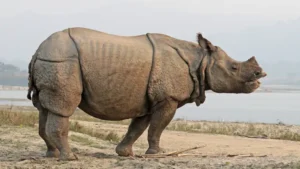
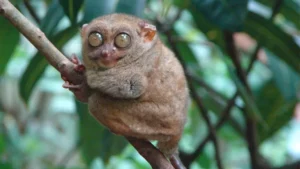


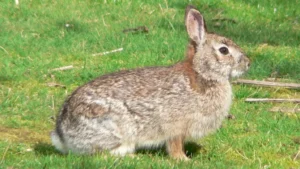
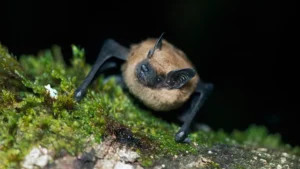
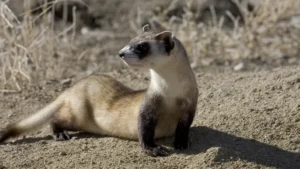

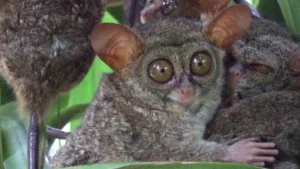
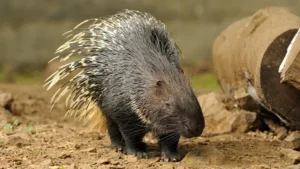
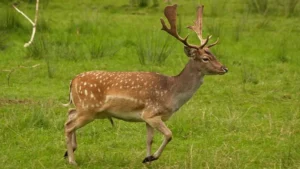

Leave your comment